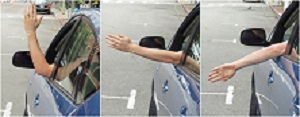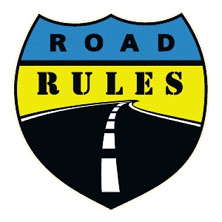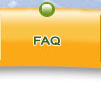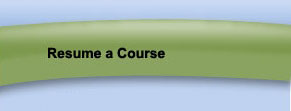|
page 8 of 11
Communication
Lights and Signals
The purpose of signaling is to let other drivers or pedestrians know of your intended maneuvers. When your turn signals are not functioning properly, then you should use arm signals. When planning to make a turn or a stop, you should signal 100 feet before doing so. When planning to make a lane change, it is recommended to signal 5 seconds prior to initiating the lane change. Any signal of intention to turn right or left shall be given continuously during the last 100 feet traveled by the vehicle before turning.
Hand Signals
 Knowing the proper hand driving-signals can be a lifesaver, especially if your turn signals or brake lights fail. Information on what you need to know about hand driving-signals is listed below
Right turn hand signal:
To signal your intention to turn right, rest your left elbow on the windowsill and raise your forearm up so it forms a 90-degree angle with your arm.
Keep your left hand open.
Knowing the proper hand driving-signals can be a lifesaver, especially if your turn signals or brake lights fail. Information on what you need to know about hand driving-signals is listed below
Right turn hand signal:
To signal your intention to turn right, rest your left elbow on the windowsill and raise your forearm up so it forms a 90-degree angle with your arm.
Keep your left hand open.
Left turn hand signal:
To make a left-turn hand signal, act as if you’re physically blocking someone with your arm.
Stick your left arm straight out with your hand extended past the side mirror.
Stop or Slow Down:
To let other drivers know that you plan to stop or slow down, stick your left arm out the window, pointing down, with your palm facing the vehicles behind you.
Eye Contact
It is perfectly acceptable not to make eye contact while driving. It is one of the few social situations where eye contact is not required. However, you may make eye contact with pedestrians, cyclists, and drivers at intersections and signal whenever you want to slow down, stop, turn, or change lanes. Keep in mind, the horn is to be used only if imminent danger is present.
Being Courteous
Make an effort to become more courteous behind the wheel and your drive will become more enjoyable and less stressful, and you will also reduce the chance of getting into a collision. Courteous driving, especially on the freeway, also includes giving more following distance between you and the car in front of you. Don’t tailgate, and allow plenty of time to stop if anything happens that forces you to do so. If someone signals their intent to enter the freeway or merge in front of you, let them in as long as doing so won’t endanger you in any way. Courteous drivers recognize that they are not in a race with all the others on the road, and they make their best effort to share the roadways in a friendly manner while keeping their vehicle running smoothly.
Knowing and Applying the Rules of the Road
 The first step to travel safely in a motor vehicle is to understand the rules of the road. On a traditional American road, traffic flows in both directions. The rule of thumb is to always stay to the right. While in motion, be sure to obey posted speed limits. Speeding is not just a ticketable offense. It is a reckless activity that greatly increases the likelihood of losing control of your vehicle and suffering or causing injury in a collision.
The first step to travel safely in a motor vehicle is to understand the rules of the road. On a traditional American road, traffic flows in both directions. The rule of thumb is to always stay to the right. While in motion, be sure to obey posted speed limits. Speeding is not just a ticketable offense. It is a reckless activity that greatly increases the likelihood of losing control of your vehicle and suffering or causing injury in a collision.
When turning, it is lawful and courteous to signal your intentions to other drivers by using your turn signal. Turning without signaling could catch another driver by surprise and is a major cause of traffic collisions in urban or residential areas. It is also important to signal your intentions when changing lanes on the freeway. A driver should apply his or her turn signal, check the rear-view mirrors, and glance over one shoulder to check the vehicle’s blind spot for traffic before changing lanes. Checking your mirrors alone is not enough. A car could be lurking in the mirror’s blind spot and cause a freeway collision.
There are many rules and regulations that a driver must follow to operate a motor vehicle in a lawful manner. It is the responsibility of the driver to follow these rules to protect themselves as well as those around them.
Identifying and Responding to Hazards
When driving on a daily basis, we want to make our driving a more enjoyable task than just getting from point A to point B. Avoiding multiple hazards, such as construction sites, pedestrians, and animals, can help drivers enjoy the driving. The following actions can be taken to avoid multiple hazards:
Identify hazards early
Predict potential hazards
Adjust your speed and position to avoid potential hazards
Anticipate and plan possible escape routes.
Compromise will go much further than an argument. It will help to reduce the risk of hazards. When in the situation of a long line of cars approaching from the opposite direction, be prepared to brake and move to the right. If an approaching vehicle drifts into your lane of travel, slow down, pull to the right, sound horn, and flash lights. When driving on a curve, slow before entering and always keep towards the right of the lane.
Also, motorists should always be on the lookout for signs that warn of road hazards. These include hills, dips, narrow bridges, bumps, and railroad tracks. Drive slowly in these areas. If a vehicle is moving too fast, the motorist may not be able to slow down in time. Speeding and applying the brakes firmly can cause a skid or a spin.
Motorists should be cautious when traveling in farm country or in open land where livestock or deer may cross the road. If a motorist encounters an animal, he/she should slow down until the animal has passed. Animals make unexpected moves, so a motorist must be alert.
|








